Abstract
A new nephelometric technique to measure C3d as an indicator of complement activation, is described. C3d is isolated at high concentration of polyethyleneglycol (PEG), incubated with commercially available anti-C3d antiserum at a final concentration of 2.5% PEG and then measured in a Behring Laser Nephelometer. In contrast to previously available techniques our assay detects the low concentrations of C3d present in all normal subjects, which result from the continuous C3 catabolism occurring in vivo. We have also measured C3d blood concentrations in a large number of patients with diseases associated with complement activation. Raised C3d concentrations were found in 68% of rheumatoid arthritis, 57% of primary biliary cirrhosis, 38% of chronic active hepatitis, 100% of Gram-negative bacteraemia and 100% of malaria. The nephelometric technique has proved to be sensitive, economical and fast, and could be adapted for routine determination of C3d blood concentrations to monitor disease activity and response to treatment.
Full text
PDF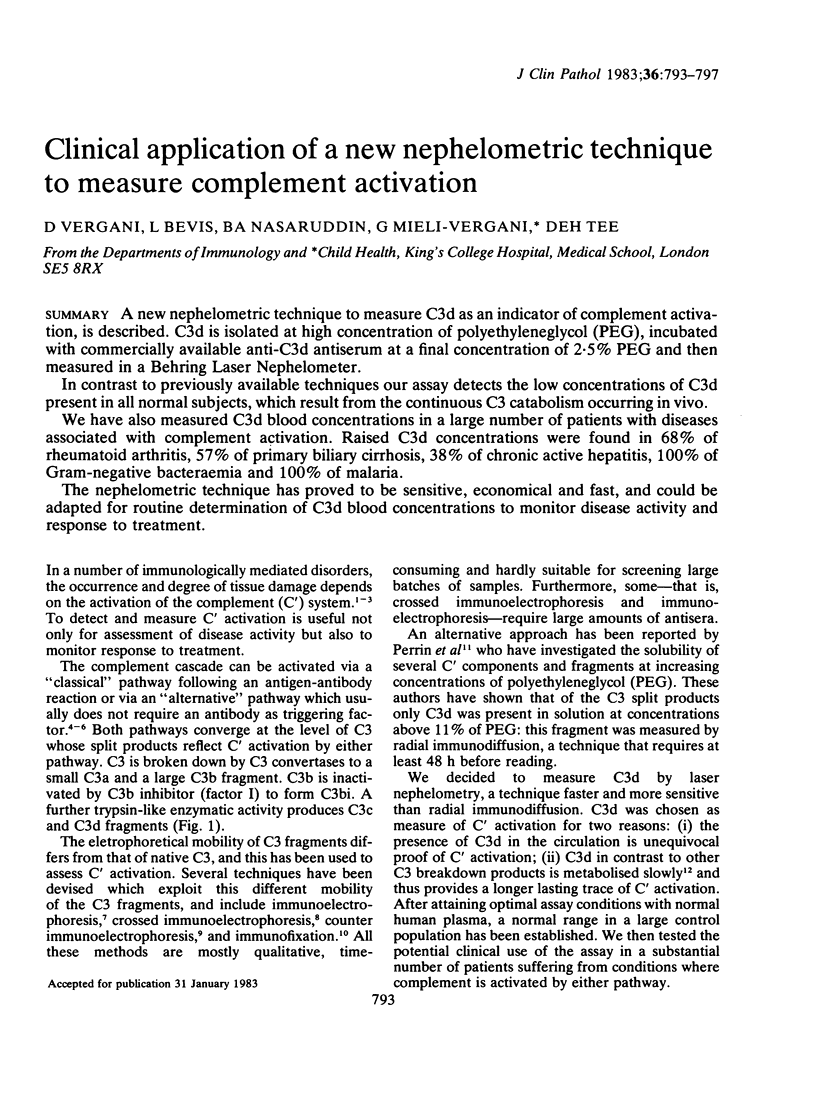
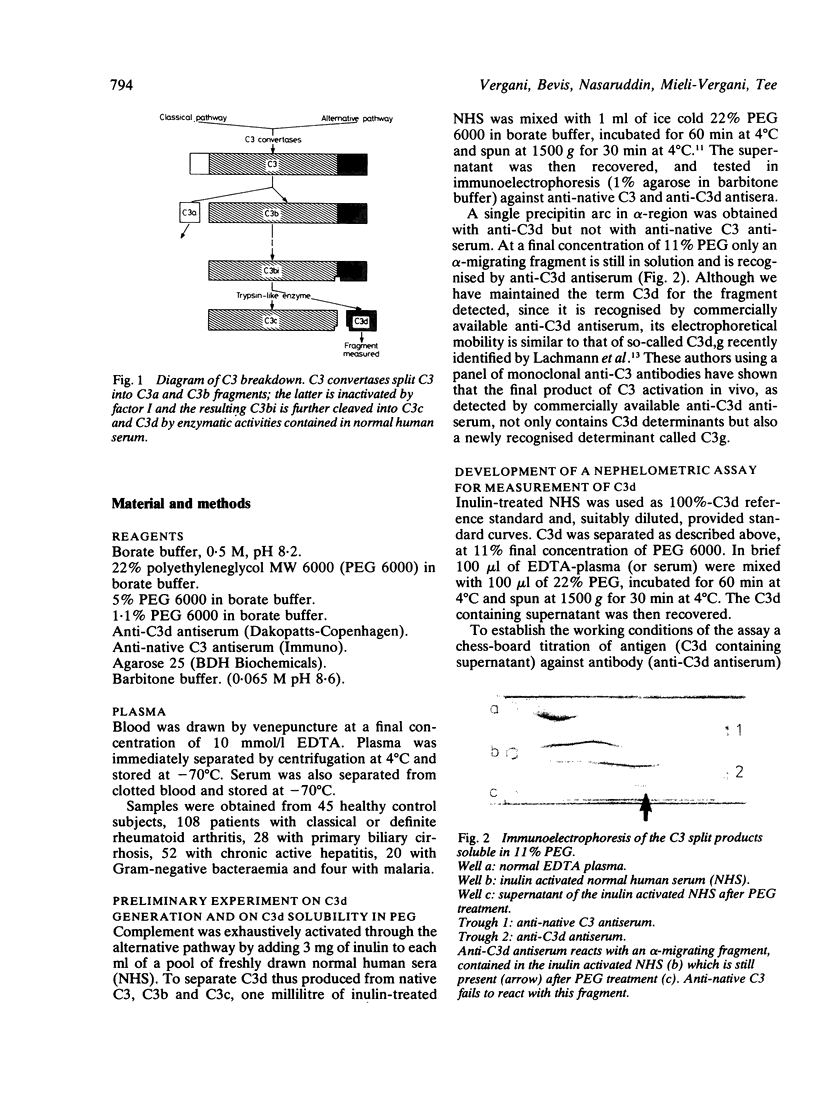
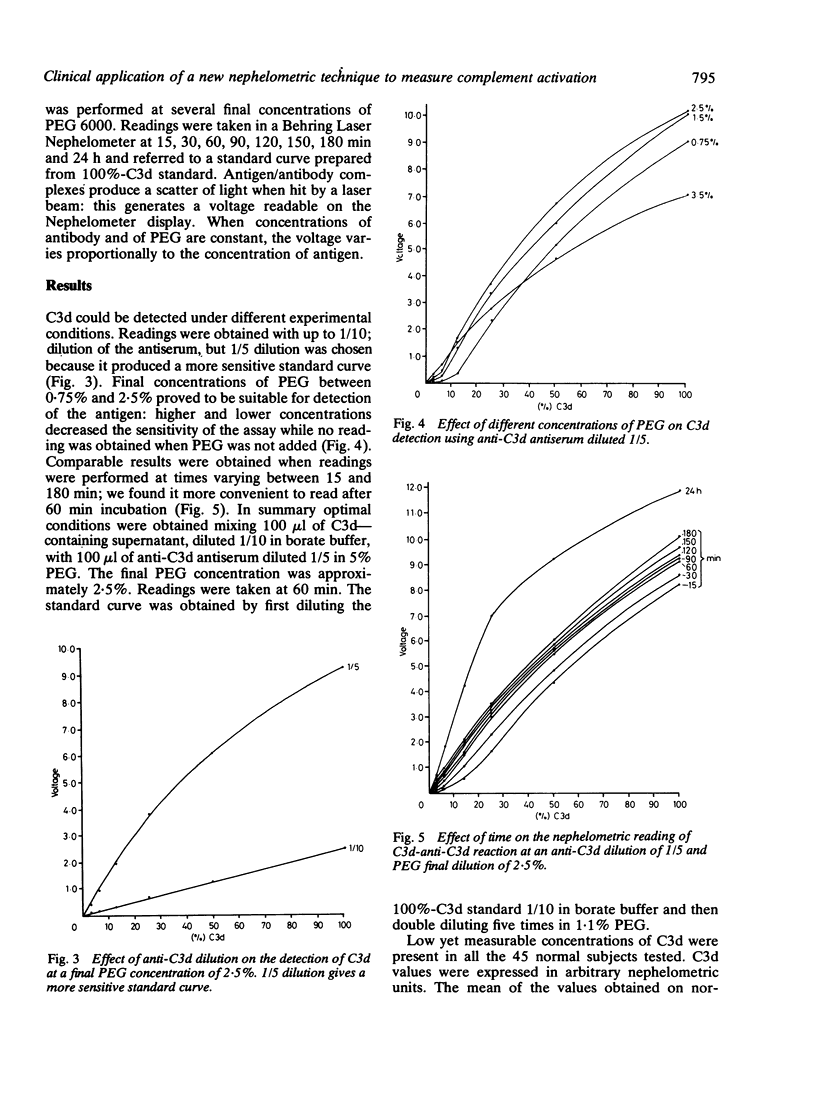
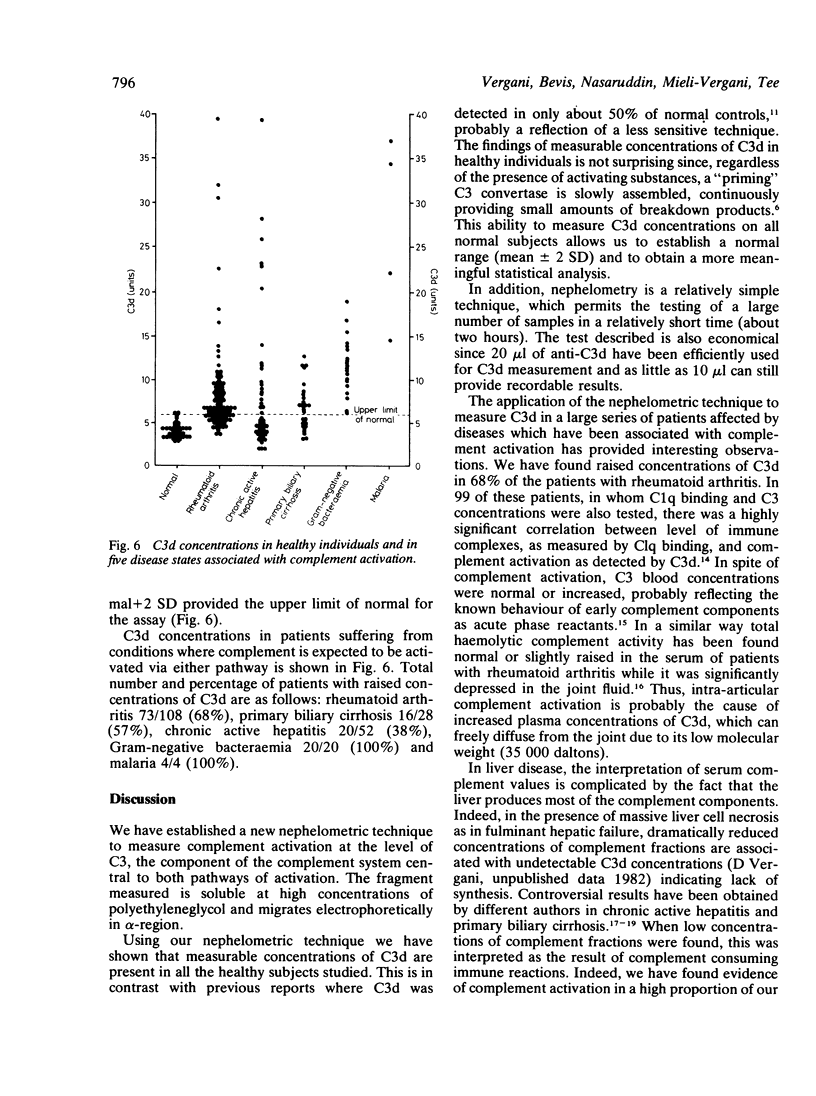
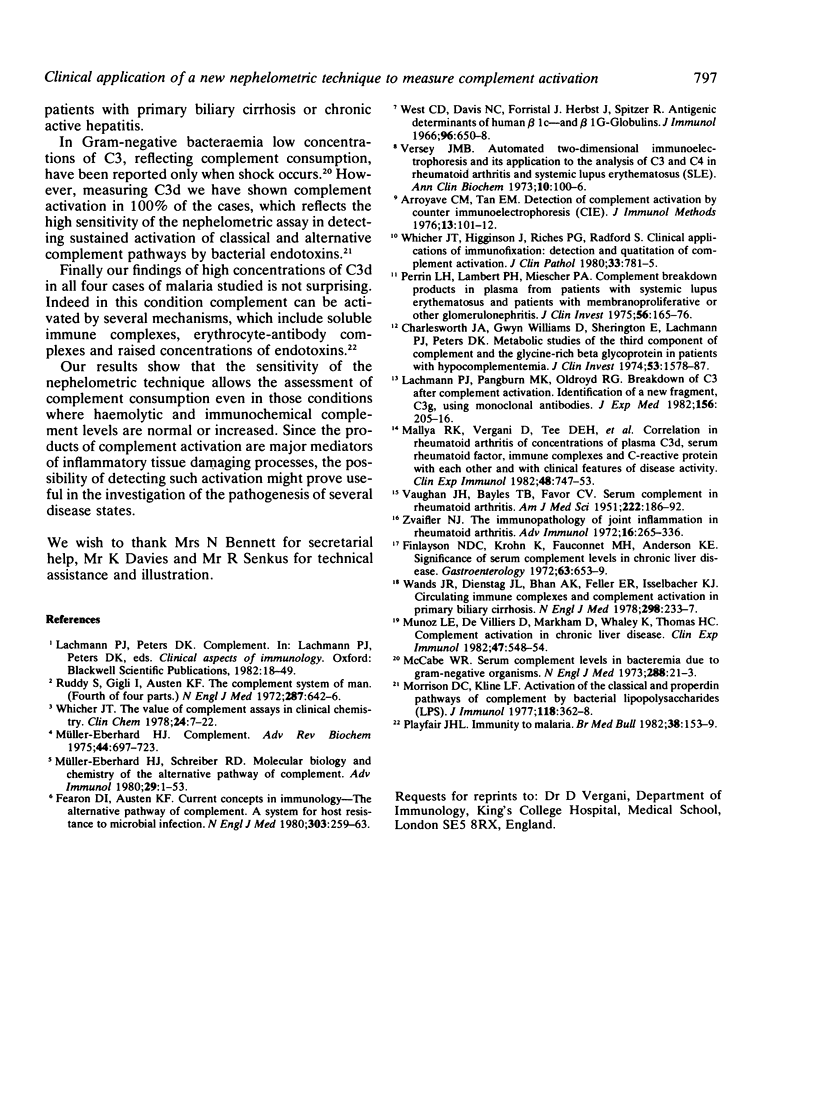
Images in this article
Selected References
These references are in PubMed. This may not be the complete list of references from this article.
- Arroyave C. M., Tan E. M. Detection of complement activation by counterimmunoelectrophoresis (CIE). J Immunol Methods. 1976;13(2):101–112. doi: 10.1016/0022-1759(76)90148-4. [DOI] [PubMed] [Google Scholar]
- Charlesworth J. A., Williams D. G., Sherington E., Lachmann P. J., Peters D. K. Metabolic studies of the third component of complement and the glycine-rich beta glycoprotein in patients with hypocomplementemia. J Clin Invest. 1974 Jun;53(6):1578–1587. doi: 10.1172/JCI107708. [DOI] [PMC free article] [PubMed] [Google Scholar]
- Fearon D. T., Austen K. F. Current concepts in immunology: the alternative pathway of complement--a system for host resistance to microbial infection. N Engl J Med. 1980 Jul 31;303(5):259–263. doi: 10.1056/NEJM198007313030505. [DOI] [PubMed] [Google Scholar]
- Finlayson N. D., Krohn K., Fauconnet M. H., Anderson K. E. Significance of serum complement levels in chronic liver disease. Gastroenterology. 1972 Oct;63(4):653–659. [PubMed] [Google Scholar]
- Lachmann P. J., Pangburn M. K., Oldroyd R. G. Breakdown of C3 after complement activation. Identification of a new fragment C3g, using monoclonal antibodies. J Exp Med. 1982 Jul 1;156(1):205–216. doi: 10.1084/jem.156.1.205. [DOI] [PMC free article] [PubMed] [Google Scholar]
- Mallya R. K., Vergani D., Tee D. E., Bevis L., de Beer F. C., Berry H., Hamilton E. D., Mace B. E., Pepys M. B. Correlation in rheumatoid arthritis of concentrations of plasma C3d, serum rheumatoid factor, immune complexes and C-reactive protein with each other and with clinical features of disease activity. Clin Exp Immunol. 1982 Jun;48(3):747–753. [PMC free article] [PubMed] [Google Scholar]
- McCabe W. R. Serum complement levels in bacteremia due to gram-negative organisms. N Engl J Med. 1973 Jan 4;288(1):21–23. doi: 10.1056/NEJM197301042880105. [DOI] [PubMed] [Google Scholar]
- Morrison D. C., Kline L. F. Activation of the classical and properdin pathways of complement by bacterial lipopolysaccharides (LPS). J Immunol. 1977 Jan;118(1):362–368. [PubMed] [Google Scholar]
- Munoz L. E., De Villiers D., Markham D., Whaley K., Thomas H. C. Complement activation in chronic liver disease. Clin Exp Immunol. 1982 Mar;47(3):548–554. [PMC free article] [PubMed] [Google Scholar]
- Müller-Eberhard H. J., Schreiber R. D. Molecular biology and chemistry of the alternative pathway of complement. Adv Immunol. 1980;29:1–53. doi: 10.1016/s0065-2776(08)60042-5. [DOI] [PubMed] [Google Scholar]
- Perrin L. H., Lambert P. H., Miescher P. A. Complement breakdown products in plasma from patients with systemic lupus erythematosus and patients with membranoproliferative or other glomerulonephritis. J Clin Invest. 1975 Jul;56(1):165–176. doi: 10.1172/JCI108065. [DOI] [PMC free article] [PubMed] [Google Scholar]
- Playfair J. H. Immunity to malaria. Br Med Bull. 1982 May;38(2):153–159. doi: 10.1093/oxfordjournals.bmb.a071752. [DOI] [PubMed] [Google Scholar]
- Ruddy S., Gigli I., Austen K. F. The complement system of man. 4. N Engl J Med. 1972 Sep 28;287(13):642–646. doi: 10.1056/NEJM197209282871306. [DOI] [PubMed] [Google Scholar]
- VAUGHAN J. H., BAYLES T. B., FAVOUR C. B. Serum complement in rheumatoid arthritis. Am J Med Sci. 1951 Aug;222(2):186–192. [PubMed] [Google Scholar]
- Wands J. R., Dienstag J. L., Bhan A. K., Feller E. R., Isselbacher K. J. Circulating immune complexes and complement activation in primary biliary cirrhosis. N Engl J Med. 1978 Feb 2;298(5):233–237. doi: 10.1056/NEJM197802022980502. [DOI] [PubMed] [Google Scholar]
- West C., Davis N. C., Forristal J., Herbst J., Spitzer R. Antigenic determinants of human beta-1c and beta-1g-globulins. J Immunol. 1966 Apr;96(4):650–658. [PubMed] [Google Scholar]
- Whicher J. T., Higginson J., Riches P. G., Radford S. Clinical applications of immunofixation: detection and quantitation of complement activation. J Clin Pathol. 1980 Aug;33(8):781–785. doi: 10.1136/jcp.33.8.781. [DOI] [PMC free article] [PubMed] [Google Scholar]
- Whicher J. T. The value of complement assays in clinical chemistry. Clin Chem. 1978 Jan;24(1):7–22. [PubMed] [Google Scholar]
- Zvaifler N. J. The immunopathology of joint inflammation in rheumatoid arthritis. Adv Immunol. 1973;16(0):265–336. doi: 10.1016/s0065-2776(08)60299-0. [DOI] [PubMed] [Google Scholar]



